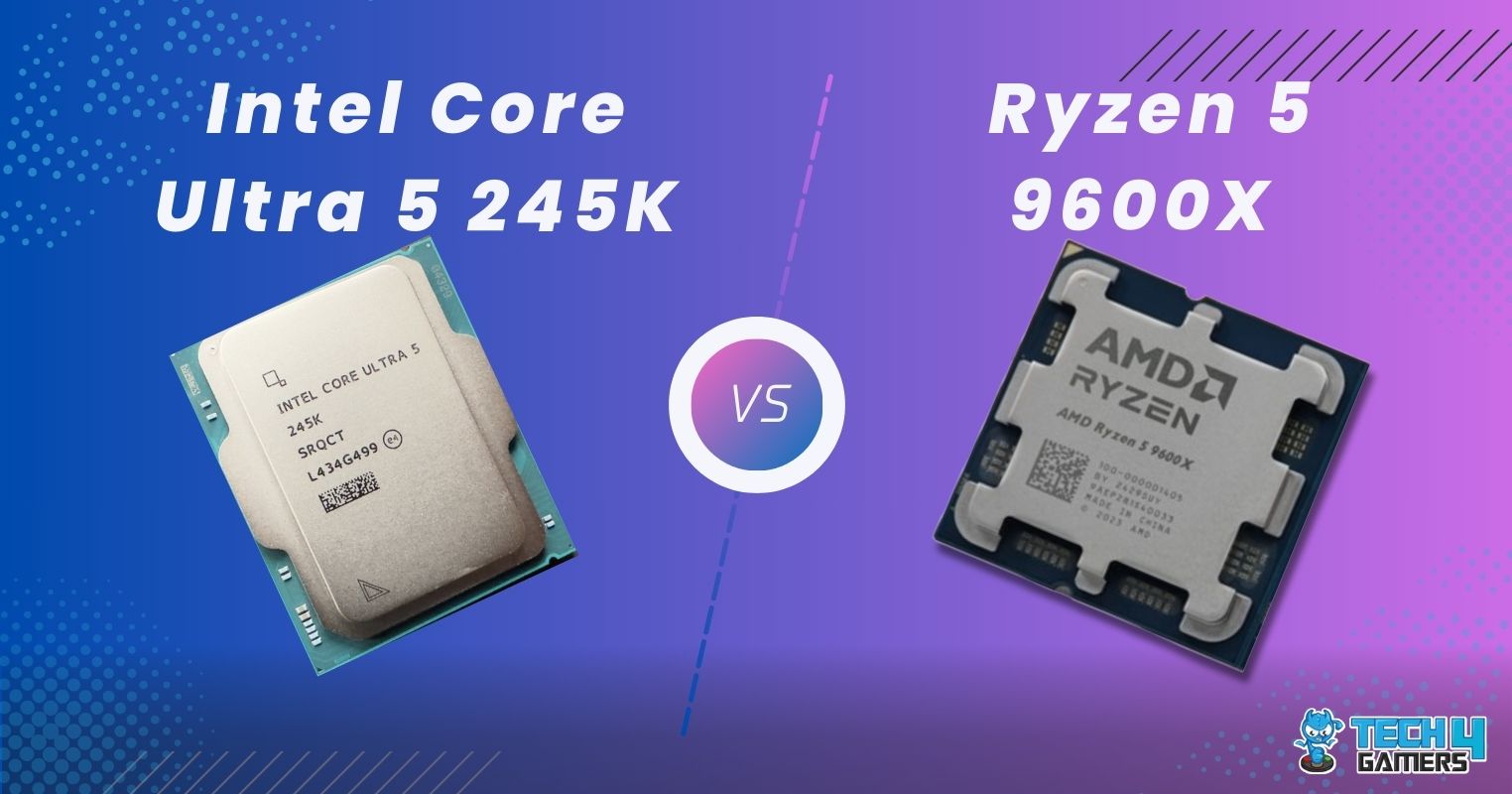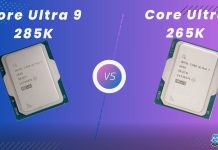With the new 14th-gen processors on the horizon, older Intel processors are falling fast in price, making them a viable option for gamers on a budget. The decision between the Core i5-13600K vs i5-12600K might be one that might confuse a lot of consumers. Not to worry, as our comparison of these two chips will give you all the necessary information to make your purchasing decision!
- Our testing of the 13600K showed a 16% advantage in average framerate, making the 12600K look sluggish in comparison.
- The difference in power consumption was higher between the two chips, but it was justified as it scaled linearly with the increase in performance.
- There is an $80 difference in price between these two processors as of the time of writing this article.
Comparison Table
| CPU Name | Intel Core i5 13600k | Intel Core i5 12600k |
|---|---|---|
| Max Memory Size | 128 GB | 128 GB |
| Memory Types | Up to DDR5 5600 MT/s Up to DDR4 3200 MT/s | Up to DDR5 4800 MT/s Up to DDR4 3200 MT/s |
| Max Memory Bandwidth | 89.6 GB/s | 76.8 GB/s |
| Processor Graphics | Intel® UHD Graphics 770 | Intel® UHD Graphics 770 |
| Graphics Base Frequency | 300 MHz | 300 MHz |
| Sockets Supported | FCLGA1700 | FCLGA1700 |
| Best Motherboards | Best Motherboards For Core i5 13600k | Best Motherboards For Core i5 12600K |
| Best CPU Coolers | Best CPU Coolers For Core i5 13600K | - |
| Best GPUs | Best GPUs For Core i5 13600k | - |
Architectural Differences
- Core Count: The i5-13600K brought some worthwhile improvement into this family of processors by using 8 efficiency cores over the 4 efficiency cores that the 12600K used. Both processors, however, use 6 performance cores. This brings the thread count up to 20 threads for the 13600K, while the 12600K has only 16 threads.
- Frequency: The 13600K can clock anywhere from 2.6GHz to 5.1GHz, while the 12600K is slightly behind on both metrics, with a frequency range of 2.8GHz to 4.9GHz.
- Cache: The Core i5-13600K has an L3 cache of 24MB, whereas the Core i5-12600K has a cache size of 20 MB. The higher cache of the 13600K should help it a lot in gaming scenarios.
- TDP: The newer chip has a max boost TDP of 181 watts, whereas the 12600K has a max TDP of 150 watts.
i5-13600K Vs i5-12600K – Gaming Benchmarks
In this section, we’ll be comparing the performances of the Intel Core i5 13600k vs Intel Core i5 12600k in 9 games. We’ll be discussing the power, temperatures, and of course, the differences in FPS of both CPUs to find just how much of a performance boost we got with the 13th gen compared to the last gen.
Test PC
- OS – Windows 11
- CPU Cooler – Cooler Master MasterLiquid Lite ML240L RGB
- SSD – XPG Gammix S70 Blade 2TB NVMe
- Power Supply – ENERMAX REVOLUTION D.F. X 1050W
- GPU – GIGABYTE RTX 3070 VISION OC
Cyberpunk 2077

- In the first game of our testing, Cyberpunk 2077 ran with an average framerate of 111 FPS on the 12600K, while the 13600K was around 12% faster with an average framerate of around 125 FPS.
- 1% lows were around 83 FPS on the older chip, whereas the 13600K only dipped down to 100 FPS during our tests.
Mount & Blade II: Bannerlord

- Our test of this game ran with an average framerate of 206 FPS on the 12600K, while the 13600K ran significantly faster with an average framerate of 246 FPS. This converts to a 17% advantage for the 13th gen processor.
- 1% lows were once again very far apart, with the 13600K dipping down to a minimum of 131 FPS, while the 12600K goes down to around 104 FPS.
Forza Horizon 5

- Forza Horizon 5 ran around 13% better on the 13600K with an average framerate of 253 FPS, while the 12600K averaged a framerate of 222 FPS in our short benchmark.
- The 1% lows were not worlds apart between these two processors in this game. The 13600K dipped to around 181 FPS, whereas the 12600K went down to around a minimum of 168 FPS.
Far Cry 6

- On average, our test of Far Cry 6 had the 13600K producing an average framerate of 123 FPS, while the Core i5-12600K had a framerate closer to 103 FPS. This difference is around 17% in favor of the 13600K.
- The 1% lows were around 81 FPS for the 12600K, whereas the 13600K was significantly smoother with a minimum framerate closer to 103 FPS.
Call of Duty: Warzone

- Once again, we saw a 17% difference in performance between the 12600K and 13600K, with the former achieving an average framerate of 179 FPS, while the latter had a framerate closer to around 210 FPS.
- The 1% lows were all over the place in this game, with 12600K hovering around a minimum of around 95 FPS, while the 13600K was also much smoother in this regard, with minimums closer to 140 FPS.
Microsoft Flight Simulator

- The 13600K had an average framerate of 74 FPS in our test of MS Flight Sim 2020, while the 12600K averaged closer to 64 FPS. This marks another 14% advantage for the newer chip.
- The 1% lows were very choppy on both processors, with the 12600K going down to around 31 FPS, whereas the 13600K was barely smoother, with a minimum of 36 FPS.
Marvel’s Spiderman Remastered

- The 12600K had an average framerate of 108 FPS in our test of Spiderman Remastered, which was around 10% lower than the 119 FPS average that we saw from the 13600K.
- As for the 1% lows, the 12600K went down to around 87 FPS during our testing, whereas the 13600K stayed closer to 95 FPS at its lowest points.
Overall Gaming Performance

There was a very measurable difference between the overall gaming performance of the Core i5-13600K vs Core i5-12600K in our tests. The average of the 12600K in terms of average framerates was around 142 FPS, which was around 16% higher than the 164 FPS average of the 13600K. The extra cores of the newer chip go a long way in providing a higher framerate than the 12600K.
As for the 1% lows, the 12600K had a framerate of around 93 FPS in the games we tested, while the 13600K had lows of around 112 FPS. This drastically impacted the smoothness of gameplay on the 12600K, making the 13600K feel a lot smoother in comparison.
The performance of the 13600K was leaps and bounds ahead of that of the 12600K, making the newer chip a great generational improvement. The performance was excellent all around, especially for a mid-range processor.
Power Consumption

The power consumption was quite different between the two processors in our testing. The 13600K had an average power consumption of around 98 watts, whereas the 12600K consumed around 83 watts on average. This compounds to a difference of around 18%.
The 13600K is just as power efficient as the 12600K because it matches its increased power consumption more or less linearly with its increase in performance, which makes us think that the extra power it takes is justified. Still, implementing smaller processing nodes would have been nicer to see efficiency improvements with the new processor.
Price And Availability
When writing this video, the i5 13600K is readily available for $300 on the new market, whereas the 12600K can be had new for around $220. A relatively large price gap between the two processors indicates both target different market segments.
Both processors should be readily available across the world in retail stores, along with the second-hand market.
What We Recommend
The data we’ve accumulated in our testing of these processors so far has given us enough information to crown a victor when it comes to comparing the Core i5-13600K vs Core i5-12600K.
The performance of the 13600K cannot be matched by its older sibling. It had a substantial 16% lead over the 12600K in the average framerates of the games we tested, while the difference in 1% lows was even larger. This urges us to recommend the 13600K to anyone with the budget.
There is still a case to be made for the 12600K for its stellar price. You can get this chip for very cheap, which allows you to set up your PC for the time being while also keeping your upgrade path very open.
In conclusion, people looking for the best performance should go with the 13600K if they can afford it, while anyone looking for a budget option with a long upgrade path should go for the 12600K.
Pros And Cons
| CPU | Pros | Cons |
|---|---|---|
| Core i5-13600K | ✅Significantly higher performance at 1080p ✅Four extra efficiency cores | ❌Substantially higher price ❌Higher power consumption |
| Core i5-12600K | ✅Low price ✅Lots of upgrade options | ❌Very noticeably lower performance |
FAQs
Yes, the Core i5-13600K and 12600K both use the LGA 1700 platform.
The power needed to drive the four extra cores of this processor makes it more power-hungry than the 12600K.
Though we didn’t test them in this comparison, our guess would be that the 12600K runs a bit cooler than the 13600K due to it not working as hard.
More From Core i5-13600K
More From Core i5-12600K
Thank you! Please share your positive feedback. 🔋
How could we improve this post? Please Help us. 😔
Feedback By:
[Comparisons Specialist]
I’m a passionate computer hardware expert specializing in CPUs and GPUs. With a lifelong curiosity for hardware and extensive hands-on experience, I provide valuable insights, practical advice, and in-depth analysis on these components. Engaging with the hardware community, I exchange knowledge and stay at the forefront of technological advancements.
Get In Touch: uzair@tech4gamers.com


 Threads
Threads




